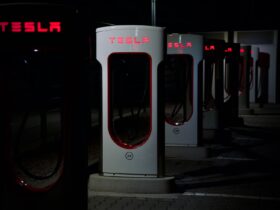The world is in the midst of an exciting revolution in transportation – the rapid rise of Evolution Electric Vehicles (EVs). EVs are changing the way people get from point A to B, with many advantages over traditional gasoline-powered cars. With their low maintenance costs, environmental friendliness, and a rapidly growing charging infrastructure, they offer a viable alternative to fossil fuel vehicles. This article will explore Rapid Rise of Evolution Electric Vehicles.
Electric Vehicles on the Rise
Electric Vehicles, or EVs, have been gaining traction in the automotive industry as environmental concerns rise and technology advances. The rapid growth of electric vehicles has been spurred by government policies to incentivize clean energy alternatives, such as EV cars. As a result, there is an ever-growing number of manufacturers producing new models with improved performance and extended battery life.
This article will explore the promising developments of electric vehicle technology that are making use of this new form of sustainable transportation more appealing than ever before.
Benefits of EVs
The rapid rise of electric vehicles (EVs) is one of the most important trends in modern transportation. Once considered to be an expensive niche market, EVs are increasingly becoming a popular choice for many people looking to reduce their carbon footprint and save money on fuel. This article explores the benefits of EVs and the potential for greater adoption of this clean and efficient form of transport.
- Lower operating costs: EVs are less expensive to operate compared to traditional gasoline vehicles, as they have lower fuel costs and maintenance costs.
- Environmental benefits: EVs have zero tailpipe emissions, meaning they do not emit harmful pollutants into the atmosphere.
- Improved air quality: By reducing emissions, EVs help improve air quality, particularly in urban areas.
- Quieter operation: EVs are much quieter than traditional gasoline vehicles, reducing noise pollution in urban areas.
- Increased energy independence: By relying on electricity instead of gasoline, EVs help reduce dependence on foreign oil.
- Increased range and battery life: Advances in battery technology have led to significant increases in the range and battery life of EVs, making them more practical for everyday use.
- Cost savings in the long run: Although the upfront cost of an EV may be higher than a traditional gasoline vehicle, the lower operating costs can lead to significant cost savings in the long run.
- Performance: Many EVs have strong acceleration and responsive handling, making them fun to drive.
- Government incentives: Many countries offer tax credits and other incentives to encourage the purchase of EVs, making them more affordable for consumers.
- Positive impact on job market: The growth of the EV market is creating new jobs in manufacturing, sales, and service, helping to stimulate local economies.


Growing Electric Vehicles Popularity
The electric vehicle (EV) market is undergoing a rapid transformation. After decades of minimal activity, EVs are now increasingly in demand among buyers all over the world. The growing popularity of EVs can be attributed to a number of factors, including improved technology, increased government support, and changing consumer preferences. This article explores the reasons for this surge in EV popularity and looks ahead to what may come next for the EV industry.
The advancement of EV technology has been one of the biggest drivers behind their rise in popularity. Battery capacities have improved exponentially over recent years, meaning that range anxiety is no longer an issue for most modern EVs. Additionally, charging times have decreased dramatically due to faster charging technologies such as DC fast-charging. These advancements mean that consumers now view EVs as viable alternatives to traditional cars driven by combustion engines.
EV Technology Innovations
The technology behind electric vehicles (EVs) is constantly evolving, and recent innovations have led to significant improvements in battery performance, charging capabilities, and vehicle design. Lithium-ion batteries, which power most EVs, have become more efficient, longer-lasting, and lighter, allowing for longer driving ranges and faster charging times. The development of fast-charging networks and home charging stations has made it easier for EV owners to keep their vehicles charged and ready to go.
In addition, new advancements in vehicle design and manufacturing processes have led to lighter and more aerodynamic vehicles, further improving efficiency and range. The continued innovation in EV technology is driving the growth of the EV market and making them a more practical and attractive option for everyday transportation.
Global EV Market Outlook
The global evolution electric vehicles (EV) market is on the rise, with more consumers recognizing the benefits of switching to an eco-friendly and efficient mode of transportation. Despite being relatively new to the automotive industry, EV technology has been rapidly adopted around the world due to its potential to reduce emissions and fuel costs. This article will explore the rapid evolution of EVs, their current market outlook, as well as future projections for this dynamic industry.
Recent years have seen a dramatic increase in EV sales across all major markets. In 2020 alone, there were over 3 million EV registrations worldwide – representing a 38% increase from 2019. This growth can be attributed to several factors such as government incentives for purchasers, improved performance and range capabilities of EVs, and rising environmental awareness among consumers.
Conclusion
As the market continues to grow, evolution electric vehicles (EVs) are quickly becoming the preferred mode of transportation for many drivers. After exploring the rapid rise of EVs in this article, it is evident that their future potential is limitless. Although there are still some challenges that need to be addressed, such as range anxiety and charging infrastructure availability, these issues can be solved with continued research and investment in new technologies.
The EV industry has already seen immense growth even before the introduction of more sustainable batteries and charging networks. With further advancements in battery technology, increased government incentives for purchasing electric vehicles, and a larger selection of models available from automakers worldwide, the future of EVs looks incredibly promising. Drivers will have access to affordable cars with longer ranges while also being able to reduce their carbon footprint with every mile they drive.




